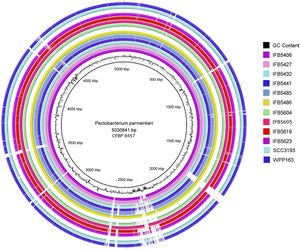Pectobacterium parmentieri
| Literature database |
|---|
| 23 articles sorted by: |
| • year (descending) |
| • research topics |
| • countries/regions |
| • host plants |
| • list of antagonists |

Author(s): S. Zoledowska et al.
Source: BMC Genomics (2018), vol. 19, art. 751
Pectobacterium parmentieri Khayi et al. 2016
This bacterium is similar to Pectobacterium carotovorum and is one of several Pectobacterium species described as a result of taxonomic re-evaluations of P. carotovorum. Before its description in 2016, it has been called strain SCC3193 of P. carotovorum, a strain which at one stage had been assigned to Pectobacterium wasabiae. P. parmentieri is now known to be common in potato growing areas around the world, being one of the causes of the important blackleg and soft rot diseases of potatoes in the field and in storage. Serious outbreaks caused by P. parmentieri have been reported.
Symptoms caused by P. parmentieri are similar to those caused by Dickeya dianthicola, involving dark brown to black decay of the stems of the potato plants in the field, with the disease developing rapidly and often resulting in death of the plant. However, while the rot caused by D. dianthicola starts mainly inside the stem with extensive necrosis, the rot caused by P. parmentieri initially involves the outside, cortical tissue. Epidemics can develop quickly, mainly under wet conditions. Tubers contaminated with the bacterium rot in storage.